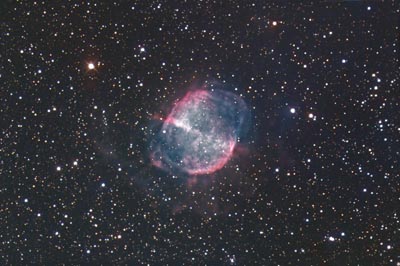There are numerous planetary nebula in the sky, over 3000 in fact that are known in our own galaxy. One of the closest and most detailed is the commonly photographed M27 in Vulpecula. This new image however, goes beyond the simple hour long "snapshots" taken by most astrophotographers, and combines 8 hours worth of images in a variety of wavelengths. Such depth records the outer red and blue shell surrounding the nebula, and a variety of red protrusions around its disk. I've left the background slightly light to assist seeing the faint outer shells. Processing: Six hours of Hydrogen Alpha data was processed in Picture Window Pro with curves to create an image with both dim and bright nebulosity without saturation. This was combined with an hour of white light data in Photoshop with "Lighten" , which keeps all the faint nebulosity of the Ha data and all of the stars of the white light data in one stunning image. DDP was applied to the RGBB data as to extend the range of colonization to the outer nebulosity. Instrument: 12.5" f/5 Home made Newtonian Platform: Astrophysics 1200 QMD CCD Camera: SBIG ST8i NABG with Enhanced Cooling Guider: SBIG ST4 Exposure: (L^Ha)RGB = 7h:20m:20m:40m (RGB Binned 2x2) RGB Combine Ratio: 1: .8: 1.2 Filters: RGB Tricolor Location: Payson, Arizona Elevation: 5150 ft. Sky: Seeing FWHM = 4.5 arcsec (Maxim DL - 10min subframe), Transparency 7/10 Outside Temperature: 15 C CCD Temperature: -20 C Processing Tools: Maxim DL, Photoshop, AIP4WIN, PW Pro, RW Debloomer.
|
||||
|
|
||||
|
FastCounter by bCentral |
